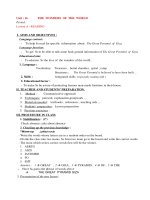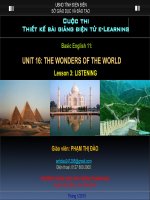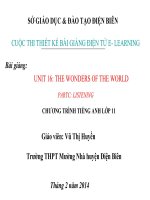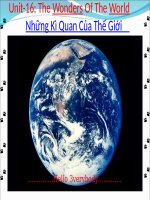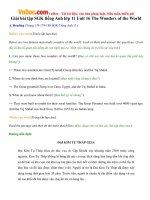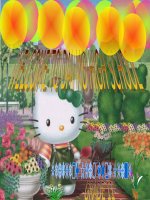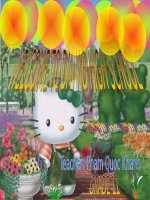Unit 16: The wonders of the world
Bạn đang xem bản rút gọn của tài liệu. Xem và tải ngay bản đầy đủ của tài liệu tại đây (120.21 KB, 8 trang )
Date of preparation: Date of signing:
Distributive period: 97 Date of teaching:
Unit 16
the wonders of the world
Lesson 1
Reading
A. Aims and Objectives: By the end of the lesson, students will be able to:
- Read and understand about space conquest.
- Skim for general ideas.
- Scan for specific ideas.
B. Materials and Teaching Aids: Textbook, handouts, pictures.
C. Procedures:
Stages/Time Activities Interactions
1. Warm-up
7 minutes
* Game: Word hunting
- Divide the class into two groups.
- T prepares a song beforehand from the tape. T asks Ss to listen to
the song. After listening to it, they have to write down the words
consisting letters: e, w, r, o, n, d from the song. T asks one
student of each group to go to the board and write the answer. The
group with more correct words wins the game.
- T asks Ss to answer the question.
+ Question:
1. Who can use the letters: e, w, r, o, n, d to make a meaningful
word?
+ Answer key: Wonder
- Declare the winner.
- Lead in: T asks Ss to tell her some wonders in the word. (The
Pyramids, The Great Wall, The Lighthouse...)
T <--> Ss
T <--> Ss
2. Pre-
reading
8 minutes
* Questions:
- T asks Ss to answer some questions:
1. Can you name these two wonders of the world?
2. Where do you think they are located?
3. What do you know about them?
+ Suggested answers:
1. These two wonders are the Great Pyramid Cheop (Khufu), and
the Taj Mahal.
2. The Great Pyramid Cheop in Cariro, Egypt, and the Taj Mahal in
India.
3. They were built as tombs for their royal families. The Great
Pyramid was built over 4000 years ago. And the Taj Mahal was
built between 1630 and 1652 by an Indian prince.
* Teaching Vocabulary:
- T asks Ss to skim the passage and underline the new words.
- T explains the new words.
1. tomb (n) (picture)
2. pyramid (n) (picture)
3. construction (n) (gap-fill)
He designed the houses. He works for a famous construction
company.
4. treasure (n) (translation): kho b¸u
- Ask Ss to give the Vietnamese equivalent (if necessary).
T <--> Ss
T <--> Ss
1
- Read a new word three times. Ss listen and repeat after the
teacher.
3. While-
reading
20 minutes
* Activity 1: Gap-fill
- Ask Ss to read the text and do task 1 in pairs.
- Instruction: The words in the box all appear in passage. Fill each
blank with a suitable word.
- Move around to help Ss.
- Go over the answers with the class.
+ Answer key: 1. tomb 2. wonder 3. ramp
4. chamber 5. mysterious 6. spiral
* Activity 2: Questions and answers
- T divides the class into groups of four or five.
- Ask each group to read the text again and write down the answers
to the following questions.
- T moves around class to give help.
+ Suggested answer:
1. It is located on the west bank of the Nile River and was built
around the year 2560 BC.
2. It was about 147 meters high on a base of 230 meters square.
3. The purpose of this huge stone pyramid was to serve as a tomb
when the Egyptian Pharaoh Khufu died and to protect the burial
chamber from the weather and from thieves who might try to steal
the treasures and belongings there.
4. It is thought that the ancient Egyptian used straight or spiral
ramps or huge weight arms to lift and place the blocks of stone in
place.
5. The boat is believed to have been used to carry the body of
Khuful in his last journey on Earth before being buried inside the
pyramid.
+ Feedback: Teacher asks some Ss to ask and answer the
questions.
Activity 3: Scan for information
- Ask Ss to scan the passage and work in pairs to say what the
following words refer to.
- T moves around class to give help.
+ Suggested answers:
1. who (line 4) refers to the thieves.
2. it (line 8) refers to the Great Pyramid.
3. it (line 9) refers to the Great Pyramid.
4. each (line 12) refers to the block of stone.
Ss <--> Ss
T <--> Ss
T <--> Ss
Ss <--> Ss
T <--> Ss
S <--> S
4. Post-
reading
8 minutes
* Discussion
- Ask Ss to work in pairs to discuss this question:
Which of the wonders of the world do you like best? Why?
- Move around to help Ss.
- Ask some pairs to act out their conversation.
- T gives feedback.
T <--> Ss
S <--> S
5. Homework
2 minutes
- Learn by heart the words in reading part.
- Prepare the next part.
Ss <--> Ss
D. To instruct Ss how to do the homework
...................................................................................................................................................................
...................................................................................................................................................................
...................................................................................................................................................................
...................................................................................................................................................................
E. Self study:–
2
Date of preparation: Date of signing:
Distributive period: 98 Date of teaching:
Unit 16
the wonders of the world
Lesson 2
Speaking
A. Aims and Objectives: By the end of the lesson, students will be able to:
- Express their own ideas about facts and opinions.
- Use facts and opinions to talk about features of man-made places.
B. Teaching Aids: Textbook, handouts.
C. Procedures:
Stages/Time Activities Interactions
1. Warm-up
5 minutes
* Little things
- Divide the class into two groups. The teacher is going to ask Ss
to give her some “Little” things. The members in each group have
to give T the thing she needs as quickly as possible. When the Ss
give one thing, they will get one mark for his group. The group
with more marks wins the games. There will be 8 things.
T says: I need a pen/ ruler/ book/ pencil/ watch/ note of money/
notebook/ eraser.
- T declares the winner.
T <--> Ss
2. Pre-
speaking
8 minutes
+ Lead-in:
- T sticks the picture of the Great Pyramid on the board and asks
Ss:
1. What is this? ( The Great Pyramid)
2. Is the Great Pyramid high? (Yes)
3. What do you think about the Great Pyramid? (I think it is great)
- T writes on the board:
+ The Great Pyramid is high.
+ The Great Pyramid is great.
- T asks Ss: Which sentence describes fact and which one
describes opinion?
+ Expected answers: The first describes fact and the second
describes opinion.
T <--> Ss
Ss <--> Ss
3. While-
speaking
20 minutes
* Activity 1: Distinguish facts and opinion
- Ask Ss to work in pairs to read the statements and decide if each
one describes fact or opinion.
- Walk round and help them, give the some information.
+ Feedback: Teacher asks some Ss to give their answers.
+ Suggested answers:
- Facts: 2, 3, 4.
- Opinions: 1, 5, 6, 7.
* Activity 2: Pair-work
+ Useful language:
- To express opinions and facts:
I think/ I am sure...
It is said/ believed/ thought that...
They might/ may / can have...
Probably/ Maybe they...
Example:
I think the Great Pyramid was built by an enormous giant.
T <--> Ss
Ss <--> Ss
3
- Ask Ss to work in pairs and tell their partner about some facts
and opinions of the Great Pyramid of Giza, using the information
in Task 1.
Example:
Fact: The Great Pyramid of Giza was 147 metres high.
Opinion: The Great Pyramid is believed to have been built over a
20-year period.
- Walk round and help them, give the some information.
+ Feedback: Teacher asks some Ss to give their answers.
Ss <--> Ss
4. Post
-speaking
10 minutes
* Group work
- Ask Ss to discuss possible answers to the following questions.
- Walk round and help them, give the some information.
- Listen to Ss and collect their mistakes for indirect correction.
- T gives feedback.
+ Suggestions:
- The Great Pyramid of Giza was built by an Egyptian Pharaoh
Khufu.
- It is said that it took him a 20-year period to complete it.
- They are now many theories about it. One theory says the stones
were taken from the site on the Giza Plateau, about 5 km away,
and one other theory says the stones were transported from the east
side of the Nile River from a distance of over 500 miles.
- These stones might have been transported on wooden sleds.
T <--> Ss
Ss <--> Ss
5. Homework
2 minutes
- Write a report on what your friend told you about how the Great
Pyramid was built in activity above.
- Prepare the next part.
T <--> Ss
D. To instruct Ss how to do the homework
...................................................................................................................................................................
...................................................................................................................................................................
...................................................................................................................................................................
...................................................................................................................................................................
E. Self study:–
...................................................................................................................................................................
...................................................................................................................................................................
...................................................................................................................................................................
...................................................................................................................................................................
Date of preparation: Date of signing:
Distributive period: 99 Date of teaching:
Unit 16
the wonders of the world
Lesson 3 Listening
A. Aims and Objectives: By the end of the lesson, students will be able to:
- Listen for specific information about the Great Wall.
- Listen for general ideas.
B. Materials and Teaching Aids: picture, a tape CD, colored chalk.
C. Procedures:
Stages/Time Activities Interactions
1. Warm-up
5 minutes
* Game: Guessing a noun phrase
- Divide the class into two groups. T tells Ss that T is thinking
about a noun phrase. T will give some clues about the noun phrase
and members of each group can make a guess about the noun
phrase at any time. Each group has only two chances to guess
about the noun phrase. The first group to give the correct answer
T <--> Ss
Ss <--> Ss
4
will win the game.
* Cues:
1. This word is a noun phrase with three words. It is one of the
wonders of the world.
2. It is enlisted in the World Heritage by UNESCO.
3. It is the symbol of China.
4. We can see it from the Moon.
* Key word: The Great Wall
- Declare the winner.
* Lead-in:
- In today’s lesson, you are going to listen about the Great Wall.
2. Pre-
listening
8 minutes
* Questions
- Ask Ss some questions:
+ Have you ever seen the Great Wall on TV?
+ How old do you think it is?
+ Would you like to visit it some day?
- Ss’ answers may vary.
* Teaching vocabulary
- T helps Ss understand some new words.
1. ancient (adj) = very old
2. Ming Dynasty (n): (translation) TriÒu ®¹i nhµ Minh
3. significance (n) = importance
4. Beijing (n): (explanation) The capital of China
+ Checking Vocabulary: - Elicit the new words by asking
questions, using the techniques suggested above.
- Ask Ss to give the Vietnamese equivalent (if necessary).
- Read a new word three times. Ss listen and repeat after the T.
T <--> Ss
T <--> Ss
3. While
-listening
20 minutes
*Activity 1 : True or false
- Ask Ss to read task 1 carefully, guess the answers. Listen to the
tape twice and decide the answers.
- Ask Ss to compare their answers.
- T gives the handouts.
+ Feedback: - Let them call out their answers.
+ Key: 1. the Moon 2. 1987 3. the Ming Dynasty
4. 200 5. 200 B.C 6. 6,000 km
7. 11 meters 8. stones
*Activity 2: * Questions and answers:
- Ask Ss to work in pairs to discuss the following question:
- Ask Ss to read the questions carefully before they listen to the
recording again (twice).
- Ask them to listen and take notes the answers.
- Ss exchange their answers.
- Check If Ss have the same answers.
- Ask Ss to listen to the recording for the last time and check their
answers.
- Go over the answers with the class.
+ Key:
1. The ancient Chinese started to build the Great Wall in 1368.
2. (It covers) 5 provinces.
3. Because it can be seen from the Moon.
4. It’s the part in the northwest of Beijing, for it is still in its
original state.
T <--> Ss
S <--> S
T <--> Ss
Ss<--> Ss
* Group work
- Ask Ss to work in groups to tell their partners why the Great
Wall is considered one of the greatest wonder in the world and
T <--> Ss
Ss<--> Ss
5
